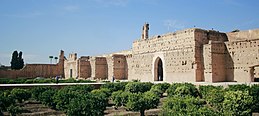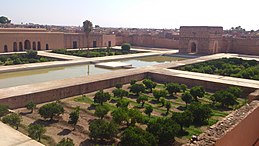el Badi Palace
The el-Badi Palace ( Arabic قصر البديع, DMG Qaṣr al-badīʿ = "the incomparable"; French Palais El-Badi ) is one of the most visited buildings in the former Moroccan royal city of Marrakech .
location
The el-Badi Palace is located in the Kasbah district, about 1 km south of Jemaa el Fna Square, not far from the Saadian tombs and Bab Agnaou .
history
The el-Badi Palace was built at the end of the 16th century by the Saadian Sultan Ahmad al-Mansur (ruled 1578–1603) after his victory over the Portuguese in the " Battle of the Three. It was extremely lucrative because of the spoils of war and the ransom money. " Kings ”from Ksar el Kebir (1578). Against the background of the extraordinarily rich marble furnishings, previously unknown in Morocco, and the good trade relations with Italy (especially in the trade in cane sugar ), the involvement of Genoese or Florentine stonemasons was suspected. The palace was stripped of all its splendor under the Alawid Sultan Mulai Ismail (r. 1672–1727); Marble slabs and even the columns were brought to Meknes on beasts of burden and reused there as spoil in the construction of the palaces of the new royal city (Ville impériale) - but much of it was also broken during expansion and transport over the mountains of the Middle Atlas .
architecture
The palace is surrounded by an approx. 135 × 110 m long rammed earth wall with only a few entrance gates. Not much has been preserved of the buildings that were once leaned against the wall: the mosque without minarets is located at today's entrance gate ; a few meters behind, the ruins of the former throne room can be recognized by the remains of floor tiles. On the south side of the courtyard area is the royal bath ( hammam ) with its partly star-shaped perforated vault. The entire courtyard was divided into four segments; Fruit trees ( fig , pomegranate trees ) and fragrant flower bushes ( oranges , jasmine ) were planted here; in the middle there was an elongated, shallow water basin. Only a few remaining, richly worked marble capitals, which were difficult to transport due to their size and weight, are a reminder of the former glory.
Minbar of the Koutoubia Mosque
The magnificent 2 m high prayer chair ( minbar ) of the prayer leader ( imam ) of the Koutoubia mosque , probably made in the years around 1120/35 under the Almoravids (possibly in Cordoba ), is a masterpiece of the Moorish style ; it was restored towards the end of the 20th century and is now located in an annex building to the palace. While the extremely fine-grained inlays of the braided band ornamentation on the outside present geometric shapes (stars and rhombuses), there are small blind arches in the decor of the stairs and in the backrest .
Marrakech Museum for Photography and Visual Arts (MMP)
The new building of the Marrakech Museum for Photography and Visual Arts (MMP) should be built next to the palace grounds by 2016 .
Marrakech Folklore Festival
Every year in June, the Marrakech Folklore Festival takes place in the El Badi Palace.
literature
- Arnold Betten: Morocco. Antiquity, Berber Traditions and Islam - History, Art and Culture in the Maghreb. DuMont, Ostfildern 2012, ISBN 978-3-7701-3935-4 ,
pp. 275ff.
Web links
Individual evidence
Coordinates: 31 ° 37 ′ 7 ″ N , 7 ° 59 ′ 9 ″ W.


